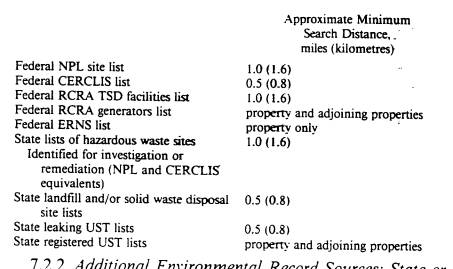
Module 12, continued
Environmental Site Assessments
Reading the introduction, you may have perceived a trap for the environmental consultant and the purchaser of potentially contaminated property. Suppose a site is contaminated and the consultant overlooks some contamination. Later, after the new purchaser has improved the property, the contamination is found. (This often happens when the purchaser starts site clearing and foundation excavation, but sometimes it happens later, when neighbors' drinking water starts to smell.) The state or federal environmental agency may claim that the purchaser hired a meatball consultant to get an easy go ahead for the project, and therefore the purchaser should be liable for the cleanup. Or perhaps the purchaser has a clearly competent consultant that blundered and the purchaser now wants the consultant and his insurance policy to pay for the cleanup and/or the purchaser's damages.
Either situation when it got to court would require a standard of diligence. Just what is required for a "sufficient" environmental site assessment. Consultants don't have x-ray vision, and not all contamination is obvious. How many soil samples and boreholes need to be taken? As a practical matter, these questions are resolved, or at least resolution is facilitated, by consensus standards. There is a standard guidance document, ASTM 1527, which goes a long way toward resolving these issues. (Go to ASTM, then use the search "E1527.") ASTM provides its services by selling standards, all you will find at the link is some prefatory information. You can get a pdf copy of this standard sent to your computer for $40, but you don't need it for this course. Some consultants, major banks, have similar forms of their own.
Suppose you are assessing a site and don't see much and are about to go home. But someone tells you that there was a PCB incinerator located a quarter a mile upwind. So maybe you should take some soil samples for PCBs or Dioxins. For that matter, there may be several sources of pollution that might migrate onto your site. The nature of these sources would dictate some of your on site sampling or other assessing strategy. How far from your site do you need to investigate if you are using "due diligence?" Here is a table from ASTM 1527:

which tells you to check the NPL (National Priorities List, i.e., Superfund sites) for sources of contamination within 1 mile of the property you are assessing, etc.
I recommend you buy ASTM 1527 if you are considering environmental site assessments. Your firm should have a copy, or perhaps it has digested the ASTM standard and made a checklist and SOPs from it.
Just a word about ethics. There is a professional argument against having such standards. The argument is that you should use your professional judgment on each case. Why waste the clients money on investigations that the standard calls for, if your judgment indicates they are not necessary. If more investigations than the standard are called for, they must be done to protect the client and the public, regardless of the standard. Very good and cogent arguments. Just use the standard. If you find something obvious that goes beyond the standard, you are ethically obliged to follow up on it, of course. If you do less then the standard and a problem comes up later, you will be hung for not following the standard, regardless whether or not the problem had anything to do with the standard. You will appear to be a corner cutter. I should mention that the standard itself has many sections that allow the consultant to use judgment, but for these, if you wind up doing less than the standard suggests, be sure to document why you knew that less was still sufficient - in the particular case.